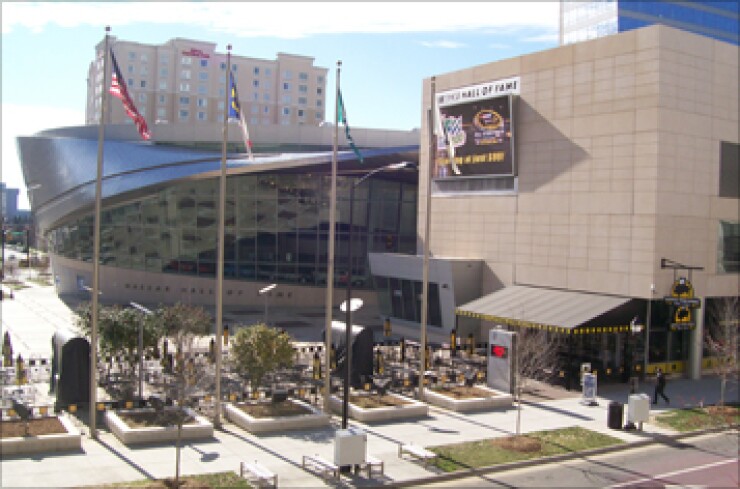
BRADENTON, Fla. — The Charlotte, N.C., City Council has agreed to restructure two non-recourse bank loans obtained as part of the financing to build the NASCAR Hall of Fame.
In return for a $5 million payment and other concessions, Bank of America and Wells Fargo agreed to write off $17.8 million in loans secured by sponsorships, brick sales, and contributions — all of which have not met projections.
Attendance at the museum, named after the National Association for Stock Car Auto Racing, has also been half of what was predicted, leading to annual operational deficits.
The museum opened in early 2010, and cost $192.6 million. The project was borne out of a complicated public-private partnership between the city, the state, and NASCAR. Funding came from a number of sources.
In addition to the bank loans, Charlotte financed most of the construction with fixed and taxable variable-rate certificates of participation, which were outstanding in the amount of $128.5 million as of June 30, 2014, according to the city's comprehensive annual financial report.
The COPs are secured by payments from city revenues, and are subject to annual appropriation. The Municipal Securities Rulemaking Board's EMMA filing system indicates that debt is not impaired. The COP debt was not discussed at the meeting Monday in which the restructuring was approved.
Charlotte-based Bank of America and Wells Fargo, headquartered in San Francisco, willingly agreed to negotiate a resolution to the operational issues, and to take the loan losses, Deputy City Manager Ron Kimble told the council.
As part of the overall deal to stabilize the Hall of Fame's operations, he said that NASCAR also agreed to reduce its royalties, which also haven't met projections, and forgive $3.2 million in royalties owned since the hall opened.
The Charlotte Regional Visitors Authority, which operates the facility, plans to cut expenses and step up revenue raising activities, he said.
Council member Al Austin asked if the banks would view the city differently because of the loan write-off.
"The answer is no, because they are in agreement with the proposal," Kimble said.
If the city did not approve the deal, it could take up to 40 years to pay back the bank loans, he added. During that time, none of the sponsorship fees, brick sales, and contributions would be available to pay for operations.
"This is not a cause for celebration," said council member Ed Driggs. "The NASCAR Hall of Fame has completely failed to live up to all the projections on which its original capital structure was based."
Driggs went on to say that the complicated deal between the public and private sector "was a big reach from the outset but all parties basically allocated all of the pain."
Charlotte is not reneging on any obligation as the bank loans were secured solely from specified revenues and with no recourse to the city, Driggs said.
"If not another sponsorship is sold, if not another brick is sold, and if not another civic contribution is made the city of Charlotte will not be in default on that loan, and the banks could not ask the city for another dime," said Mayor Dan Clodfelter.
Attendance at the Hall of Fame had been around 400,000 a year, or about half of what was predicted, but dwindled in recent years below 200,000.
The hall includes a 150,000-square-foot museum, a 102,000-square-foot expansion to the city's convention center, and a 19-story Class A office tower.





